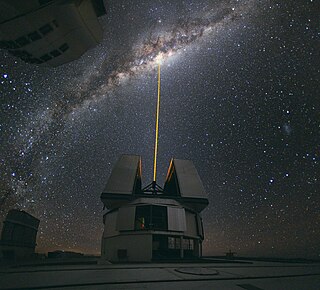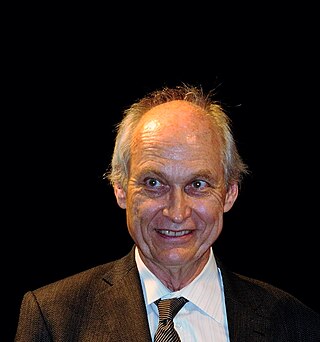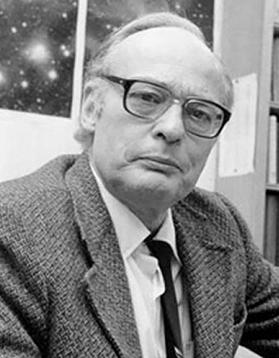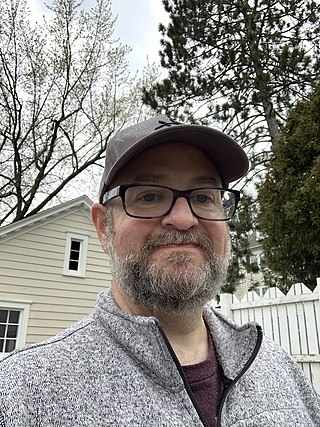Related Research Articles

The following outline is provided as an overview and topical guide to space science:

Sandra Moore Faber is an American astrophysicist known for her research on the evolution of galaxies. She is the University Professor of Astronomy and Astrophysics at the University of California, Santa Cruz, and works at the Lick Observatory. She has made discoveries linking the brightness of galaxies to the speed of stars within them and was the co-discoverer of the Faber–Jackson relation. Faber was also instrumental in designing the Keck telescopes in Hawaii.

Michael S. Turner is an American theoretical cosmologist who coined the term dark energy in 1998. He is the Rauner Distinguished Service Professor Emeritus of Physics at the University of Chicago, having previously served as the Bruce V. & Diana M. Rauner Distinguished Service Professor, and as the assistant director for Mathematical and Physical Sciences for the US National Science Foundation.
Fred C. Adams is an American astrophysicist who has made contributions to the study of physical cosmology.

Robert P. Kirshner is an American astronomer, Chief Program Officer for Science for the Gordon and Betty Moore Foundation, and the Clownes Research Professor of Science at Harvard University. Kirshner has worked in several areas of astronomy including the physics of supernovae, supernova remnants, the large-scale structure of the cosmos, and the use of supernovae to measure the expansion of the universe.

John Cromwell Mather is an American astrophysicist, cosmologist and Nobel Prize in Physics laureate for his work on the Cosmic Background Explorer Satellite (COBE) with George Smoot.

Edward R. Harrison was a British astronomer and cosmologist, noted for his work about the increase of fluctuations in the expanding universe, for his explanation of Olbers's paradox, and for his books on cosmology for lay readers. He spent much of his career at the University of Massachusetts, Amherst, and University of Arizona, both in the United States.
Christopher David Impey is a British astronomer, educator, and author. He has been a faculty member at the University of Arizona since 1986. Impey has done research on observational cosmology, in particular low surface brightness galaxies, the intergalactic medium, and surveys of active galaxies and quasars. As an educator, he has pioneered the use of instructional technology for teaching science to undergraduate non-science majors. He has written many technical articles and a series of popular science books including The Living Cosmos, How It Began, How It Ends: From You to the Universe, Dreams of Other Worlds, and Humble Before the Void. He served as Vice-President of the American Astronomical Society, he is a Fellow of the American Association for the Advancement of Science, and a Howard Hughes Medical Institute Professor. He serves on the Advisory Council of METI.
The University of California High-Performance AstroComputing Center (UC-HiPACC), based at the University of California at Santa Cruz (UCSC), is a consortium of nine University of California campuses and three Department of Energy laboratories. The consortium's goal is to support and facilitate original research and education in computational astrophysics, and to engage in public outreach and education.
Marc Kamionkowski is an American theoretical physicist and currently the William R. Kenan, Jr. Professor of Physics and Astronomy at Johns Hopkins University. His research interests include particle physics, dark matter, inflation, the cosmic microwave background and gravitational waves.
Alice Eve Shapley is a professor at the University of California, Los Angeles (UCLA) in the Department of Physics and Astronomy. She was one of the discoverers of the spiral galaxy BX442. Through her time at University of California, Los Angeles (UCLA) she has taught Nature of the Universe, Black Holes and Cosmic Catastrophes, Cosmology: Our Changing Concepts of the Universe, Galaxies, Scientific Writing, AGNs, Galaxies, *and* Writing, and The Formation and Evolution of Galaxies and the IGM. Shapley has committed herself to over a two decades of research and publication in the interest of physics and astronomy.
Ramanath Cowsik is an Indian astrophysicist and the James S. McDonnell Professor of Space Sciences at Washington University in St. Louis. He is considered by many as the father of astroparticle physics. A recipient of the Shanti Swarup Bhatnagar Prize, Cowsik was honored by the Government of India, in 2002, with the fourth highest Indian civilian award of Padma Shri

Brian Gregory Keating is an American cosmologist. He works on observations of the cosmic microwave background, leading the BICEP, POLARBEAR2 and Simons Array experiments. He received his PhD in 2000, and is a distinguished professor of physics at University of California, San Diego, since 2019. He is the author of two books, Losing The Nobel Prize and Into the Impossible.

Smadar Naoz is an Israeli-American astrophysicist, and was the 2015 winner of the Annie Jump Cannon Award in Astronomy for her scientific contributions to the fields of cosmology and planetary dynamics.
Ann Hornschemeier is an American astronomer specializing in X-ray emission from X-ray binary populations. She is the Chief Scientist for the Physics of the Cosmos program at NASA.
Aomawa L. Shields is an associate professor of physics and astronomy at UC Irvine. Her research is focused on exploring the climate and habitability of small exoplanets, using data from observatories including NASA's Kepler spacecraft. Shields was a 2015 TED Fellow, and is active in science communication and outreach. She develops interactive workshops to encourage self-esteem and teach about astronomy, combines her training in theater and her career in astronomy.
Risa H. Wechsler is an American cosmological physicist, Professor of Physics at Stanford University, and Professor of Particle Physics and Astrophysics at SLAC National Accelerator Laboratory. She is the director of the Kavli Institute for Particle Astrophysics and Cosmology.

Erika Tobiason Hamden is an American astrophysicist and assistant professor at the University of Arizona and Steward Observatory. Her research focuses on developing ultraviolet (UV) detector technology, ultraviolet–visible spectroscopy (UV/VIS) instrumentation and spectroscopy, and galaxy evolution. She served as the project scientist and project manager of a UV multi-object spectrograph, FIREBall-2, that is designed to observe the circumgalactic medium (CGM). She is a 2019 TED fellow.
Abigail Goodhue Vieregg is a professor of physics at the Enrico Fermi Institute and Kavli Institute of Cosmology, University of Chicago, specializing in neutrino astrophysics and cosmology. Her work focuses on cosmic high-energy neutrinos and mapping the cosmic microwave background.

Marc S. Seigar is an astrophysicist, academic and author. He is the Dean of the College of Natural Sciences and Mathematics, and a Professor of Physics and Astronomy at the University of Toledo.
References
- ↑ University of California, Irvine Faculty Chancellor's Fellows Archived 2012-08-01 at archive.today
- ↑ Cooray, A; Sheth, R (2002). "Halo models of large scale structure". Physics Reports. 372 (1): 1–129. arXiv: astro-ph/0206508 . Bibcode:2002PhR...372....1C. CiteSeerX 10.1.1.315.1092 . doi:10.1016/S0370-1573(02)00276-4. S2CID 119070406.
- ↑ nsf.gov - Funding - Faculty Early Career Development (CAREER) Program - US National Science Foundation (NSF)